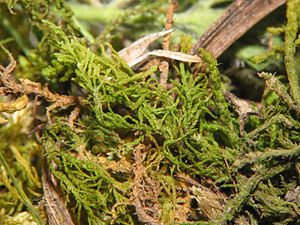Hair-tip thuja moss
| Hair-tip thuja moss | ||||||||||||
|---|---|---|---|---|---|---|---|---|---|---|---|---|

Tip of Thuja Moss ( Thuidium philibertii ) |
||||||||||||
| Systematics | ||||||||||||
|
||||||||||||
| Scientific name | ||||||||||||
| Thuidium philibertii | ||||||||||||
| Limpr. |
The dioecious hair lace Thujamoos ( Thuidium philibertii , Syn. : Thuidium assimilé ), also called "Philibert Thujamoos" is much more delicate and tender than the tamarisk-Thujamoos ( Thuidium tamariscinum ), a common forest moss.
Identifying features
It grows in yellow to brown-green loose lawns. Its stems are up to 10 cm long and have double evenly pinnate. The branches, which are often sloping upwards, are up to 1 cm long. Branched, papillary paraphyllia are not uncommon between the leaves . The lamina cells are very papillary. The midrib reaches 2/3 of the leaf length. The leaf margin cells are strongly dentate. The end cell of the leaves is 2 to 3 pointed. The leaves are often drawn out in 3 or more individual cells at the tip, which, however, break off easily (especially in the case of dried herbarium specimens). Sporogons are seldom formed. The fruit ripens in spring or autumn. The reddish colored sets are up to 1.5 cm long and have a curved, cylindrical, brownish capsule.
There is a particular risk of confusion with the very similar Thuidium delicatulum , which, however, can be most clearly demarcated from an ecological point of view. While the lime-loving Th. Philibertii mainly inhabits lime and light-rich meadows, Th. Delicatulum can be found in base-rich, moist bog or forest locations. However, there should also be transitional forms between the two types.
Occurrence
The tip of the Thuja moss colonizes nutrient-poor, light-rich, moist to dry locations on calcareous, alkaline-rich soil. It is mainly to be found in gappy meadows, semi-arid lawns, grassy areas and on slopes. Typical accompanying mosses are Calliergonella cuspidata , Scleropodium purum and possibly Bryum elegans . In addition, an increased preference for wet meadow plant communities with Filipendula , Plagiomnium affine sl and Climacium dendroides was found. Due to the intensification of use, stocks in Germany are currently declining.
literature
- Martin Nebel, Georg Philippi (ed.): The mosses of Baden-Württemberg. Volume 2: Special part, (Bryophytina II, Schistostegales to Hypnobryales). Ulmer, Stuttgart 2001, ISBN 3-8001-3530-2 .
- Jan-Peter Frahm , Wolfgang Frey : Moosflora (= UTB . 1250). 4th, revised and expanded edition. Ulmer, Stuttgart 2004, ISBN 3-8252-1250-5 .
Web links
Individual evidence
- ↑ www.swissbryophytes.ch ( Memento of the original dated December 8, 2014 in the Internet Archive ) Info: The archive link was inserted automatically and has not yet been checked. Please check the original and archive link according to the instructions and then remove this notice.

